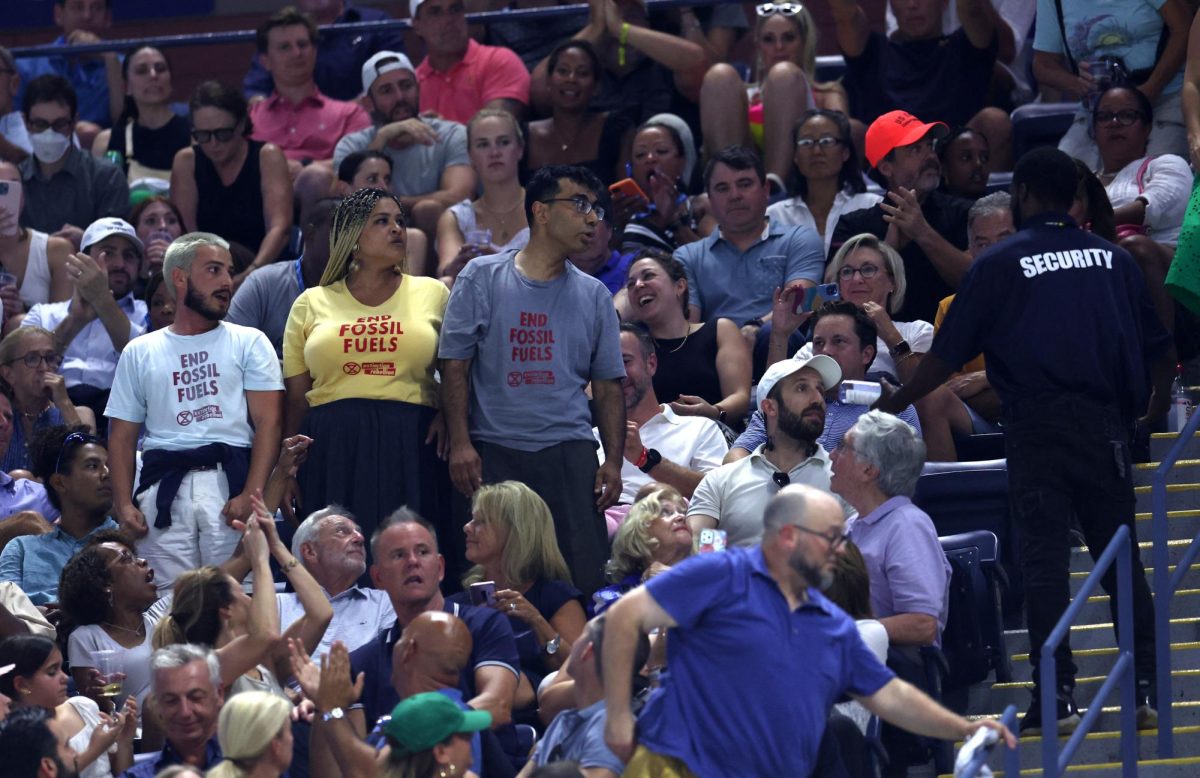During her run to becoming champion of the U.S. Open, 19-year-old Coco Gauff encountered multiple hurdles, including weather delays and oppressive heat. However, no interruption was stranger than the protest that occurred during her semifinal match Sept. 7 against Karolína Muchová.
At 6–4, 1–0, four protestors stood up and began loudly chanting, “If we don’t disrupt, climate change will,” and “End fossil fuels” — the same slogan displayed on their shirts. The demonstration stopped play for 49 minutes, and one protester, determined to create as much of a distraction as possible, glued his feet to the cement floor in the stands. He was arrested and charged with criminal trespass and disorderly conduct, and the other three protestors were taken into NYPD custody without restraint.
Extinction Rebellion, an international climate advocacy organization, took credit for the protest. The group seeks to persuade governments to “act justly on the Climate and Ecological Emergency” through non-violent direct action and civil disobedience.
“Throughout history, moments like this are definitely defining moments,” Gauff told reporters after the match. “I believe in climate change. I don’t really know exactly what they were protesting. I know it was about the environment. I 100 percent believe in that. I think there are things we can do better. I know the tournaments are doing things to do better for the environment. Would I prefer it not happening in my match? 100 percent, yeah. I’m not gonna sit here and lie. But it is what it is.”
Other players have spoken about these protests in tennis with mixed emotions. After a climate protest at Wimbledon this year, Andy Murray, a British former world No. 1, three-time Grand Slam champion, and two-time Olympic gold medalist, was similarly supportive of the message behind the protest while sharing Gauff’s displeasure at the disruption.
“I agree with the cause — just not always how they go about expressing it,” Murray said. “Rather than running on the court, maybe they could do it a different way.”
Tennis events have recently become stages for environmental advocacy protests. Multiple climate organizations have claimed responsibility for various protests within the last two years, many of which have taken place at major tennis tournaments.
At the 2022 French Open, a protester ran onto the court during the men’s semifinal match between Casper Ruud and Marin Čilić, two of the top players in the sport. She wore a shirt that read, “We have 1028 days left,” referring to a U.N. Climate Report timeline on reversing the climate crisis, and chained herself to the net post with metal wire and glue.
The protester was part of the French climate activism group Dernière Rénovation and wanted to bring attention to the climate crisis in as public a manner as possible.
“It was an act of desperation,” the protester said. “I wanted to open viewers’ eyes to the reality that we’re all going to die if we don’t do something about the climate crisis. There will be no tennis in 10 years.”
Climate protests have continued at tennis’ most important events this year, including Wimbledon. During a first-round match between Great Britain’s Katie Boulter and Australia’s Daria Saville, 66-year-old protester William Ward ran onto Court 18 and dumped orange confetti and puzzle pieces on the court.
Ward protested as a member of Just Stop Oil, a British climate advocacy group that operates in a similar manner to Dernière Rénovation. The group’s mission is to stop the U.K. government from licensing all new oil, gas, and coal projects through nonviolent civil resistance.
Ward’s peaceful but disruptive act was inspired by a climate protest he’d witnessed just days before that was peaceful, lawful, and nonviolent. He saw that it received very little coverage and took it upon himself to stage a peaceful and nonviolent, yet illegal, protest that would get the attention of the press, just like the French Open protest in 2022.
These frequent protests, which have been successful in garnering publicity, demonstrate that protesters are intentionally choosing to interrupt major championships in tennis because the global viewership of these events is incredibly high.
A study published in July indicates that protests like these are effective in delivering their intended message on climate change. In the study, 120 academic experts in sociology, political science, and other related disciplines were asked to rank the success of different forms of protest. According to the study’s primary results, the participants thought “the strategic use of nonviolent disruptive tactics” was the most conducive to a social movement’s success, and “69% of experts thought that disruptive tactics were effective for issues (like climate change) that have high public awareness and support.”
The frequency of the protests beg a few questions. Will these protests become commonplace in major tennis tournaments every year? Will they quickly spread to other sporting events like football and soccer? Will they be successful enough that governments will eventually end the use of fossil fuels?











